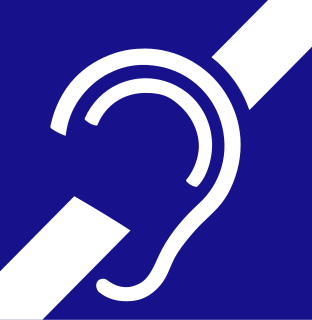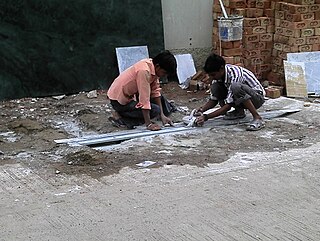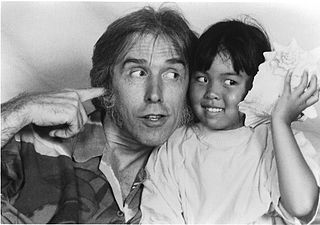Related Research Articles

Hearing loss is a partial or total inability to hear. Hearing loss may be present at birth or acquired at any time afterwards. Hearing loss may occur in one or both ears. In children, hearing problems can affect the ability to acquire spoken language, and in adults it can create difficulties with social interaction and at work. Hearing loss can be temporary or permanent. Hearing loss related to age usually affects both ears and is due to cochlear hair cell loss. In some people, particularly older people, hearing loss can result in loneliness. Deaf people usually have little to no hearing.
Tinnitus is the perception of sound when no corresponding external sound is present. Nearly everyone will experience a faint "normal tinnitus" in a completely quiet room but it is only of concern if it is bothersome or interferes with normal hearing or correlated with other problems. While often described as a ringing, it may also sound like a clicking, buzzing, hiss, or roaring. The sound may be soft or loud, low or high pitched, and often appears to be coming from one or both ears or from the head itself. In some people, the sound may interfere with concentration and in some cases it is associated with anxiety and depression. Tinnitus is usually associated with a degree of hearing loss and with decreased comprehension of speech in noisy environments. It is common, affecting about 10–15% of people. Most, however, tolerate it well, and it is a significant problem in only 1–2% of all people. The word tinnitus comes from the Latin tinnire which means "to ring".
Occupational noise is the amount of acoustic energy received by an employee's auditory system when they are working in the industry. Occupational noise, or industrial noise, is often a term used in occupational safety and health, as sustained exposure can cause permanent hearing damage. Occupational noise is considered an occupational hazard traditionally linked to loud industries such as ship-building, mining, railroad work, welding, and construction, but can be present in any workplace where hazardous noise is present.

An earplug is a device that is inserted in the ear canal to protect the user's ears from loud noises, intrusion of water, foreign bodies, dust or excessive wind. Since they reduce the sound volume, earplugs are often used to help prevent hearing loss and tinnitus.

Earmuffs are clothing accessories or personal protective equipment designed to cover a person's ears for hearing protection or for warmth. They consist of a thermoplastic or metal head-band, that fits over the top or back of the head, and a cushion or cup at each end, to cover the external ears.

Sensorineural hearing loss (SNHL) is a type of hearing loss in which the root cause lies in the inner ear or sensory organ or the vestibulocochlear nerve. SNHL accounts for about 90% of reported hearing loss. SNHL is usually permanent and can be mild, moderate, severe, profound, or total. Various other descriptors can be used depending on the shape of the audiogram, such as high frequency, low frequency, U-shaped, notched, peaked, or flat.

Hyperacusis is the increased sensitivity to sound and a low tolerance for environmental noise. Definitions of hyperacusis can vary significantly; it can refer to normal noises being perceived as: loud, annoying, painful, fear-inducing, or a combination of those, and is often categorized into four subtypes: loudness, pain, annoyance, and fear.

Noise health effects are the physical and psychological health consequences of regular exposure to consistent elevated sound levels. Noise from traffic, in particular, is considered by the World Health Organization to be one of the worst environmental stressors for humans, second only to air pollution. Elevated workplace or environmental noise can cause hearing impairment, tinnitus, hypertension, ischemic heart disease, annoyance, and sleep disturbance. Changes in the immune system and birth defects have been also attributed to noise exposure.
The Contractions is an early-Eighties all-female punk power trio based in San Francisco. The band consisted of Mary Kelley on guitar and vocals, Debbie Hopkins on drums and vocals, and Kathy Peck on bass and vocals. A review in BAM magazine calls the band "The hottest all woman group ever to come out of the Bay Area."

Noise-induced hearing loss (NIHL) is a hearing impairment resulting from exposure to loud sound. People may have a loss of perception of a narrow range of frequencies or impaired perception of sound including sensitivity to sound or ringing in the ears. When exposure to hazards such as noise occur at work and is associated with hearing loss, it is referred to as occupational hearing loss.
Don't Lose the Music is a national campaign launched by RNID, the charity representing the 9 million deaf and hard of hearing people in the UK.

Hearing conservation programs are designed to prevent hearing loss due to noise. Hearing conservation programs require knowledge about risk factors such as noise and ototoxicity, hearing, hearing loss, protective measures to prevent hearing loss at home, in school, at work, in the military and, and at social/recreational events, and legislative requirements. Regarding occupational exposures to noise, a hearing conservation program is required by the Occupational Safety and Health Administration (OSHA) "whenever employee noise exposures equal or exceed an 8-hour time-weighted average sound level (TWA) of 85 decibels (dB) measured on the A scale or, equivalently, a dose of fifty percent." This 8-hour time-weighted average is known as an exposure action value. While the Mine Safety and Health Administration (MSHA) also requires a hearing conservation program, MSHA does not require a written hearing conservation program. MSHA's hearing conservation program requirement can be found in 30 CFR § 62.150, and is very similar to the OSHA hearing conservation program requirements. Therefore, only the OSHA standard 29 CFR 1910.95 will be discussed in detail.

Loud music is music that is played at a high volume, often to the point where it disturbs others and causes hearing damage. It may include music that is sung live, played with musical instruments, or with electronic media, such as Radio broadcasting, CD, or MP3 players.
Future Sonics is an American professional audio and consumer earphones company which designs and manufactures its own proprietary MG line of full-range miniature loudspeakers used in all of its products.
Hearing Health Foundation (HHF) is a 501(c)(3) nonprofit organization whose mission is to prevent and cure hearing loss and tinnitus through groundbreaking research, and promote hearing health. In 2011, the Deafness Research Foundation changed its name to Hearing Health Foundation.

Occupational hearing loss (OHL) is hearing loss that occurs as a result of occupational hazards, such as excessive noise and ototoxic chemicals. Noise is a common workplace hazard, and recognized as the risk factor for noise-induced hearing loss and tinnitus but it is not the only risk factor that can result in a work-related hearing loss. Also, noise-induced hearing loss can result from exposures that are not restricted to the occupational setting.
Musicians experience a number of health problems related to the practice and performance of music.

A hearing protection device, also known as a HPD, is an ear protection device worn in or over the ears while exposed to hazardous noise and provide hearing protection to help prevent noise-induced hearing loss. HPDs reduce the level of the noise entering the ear. HPDs can also protect against other effects of noise exposure such as tinnitus and hyperacusis. There are many different types of HPDs available for use, including earmuffs, earplugs, electronic hearing protection devices, and semi-insert devices.
Hearing loss has multiple causes, including ageing, genetics, perinatal problems and acquired causes like noise and disease. For some kinds of hearing loss the cause may be classified as of unknown cause.

Safe listening is a framework for health promotion actions to ensure that sound-related recreational activities do not pose a risk to hearing.
References
- ↑ "H.E.A.R. | Hearing Education and Awareness for Rockers". H.E.A.R. Official Website. H.E.A.R. – Hearing Education and Awareness for Rockers, Inc.
- ↑ Archived at Ghostarchive and the Wayback Machine : 1980s - Todd Rundgren Public Service Announcement for Hearing Loss. YouTube .
- ↑ Haller, Anne Kathryn, and Judy K. Montgomery. "Noise-induced hearing loss in children: What educators need to know." Teaching Exceptional Children 36.4 (2004): 22-27.
- ↑ Whitman, D. "Percussion on the World Wide Web." PERCUSSIVE NOTES 45.3 (2007): 56.
- ↑ Loss, NYC Mayor Tackles Hearing. "Prevention." The American fire waste averages $250,000,000 per year. This is $30,000 per hour or $500 per minute. This figure does not include the huge cost of fire departments. That is an additional burden. The immensity of the burden due to losses by fire THE BUSINESS ENCYCLOPEDIA FIR (2005).